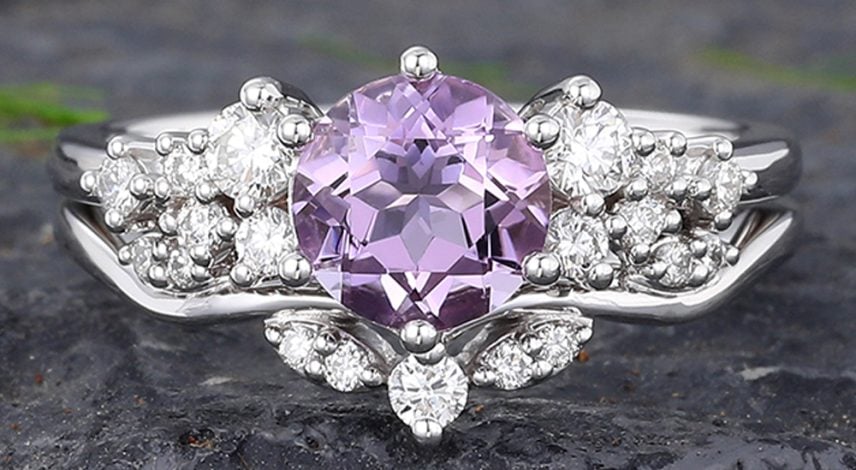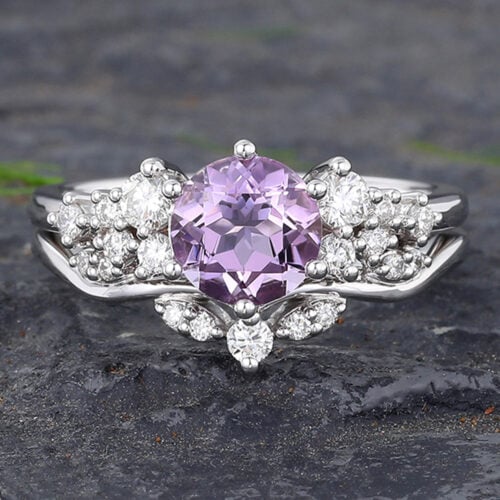


shop BY BAND STYLES
shop BY STONE ARRANGEMENTS
shop BY DESIGN STYLES
shop BY METAL COLOR
shop BY STONE TYPES
shop BY BAND STYLES
shop BY STONE ARRANGEMENTS
shop BY DESIGN STYLES
shop BY METAL COLOR
shop BY STONE TYPES
shop BY BAND STYLES
shop BY STONE ARRANGEMENTS
shop BY STONE TYPES
shop BY METAL COLOR
SHOP BY STYLE
GIFTS BY OCCASION
GIFTS BY PRICE

✚ BY BAND STYLES
✚ BY STONE ARRANGEMENTS

A promise ring is more than just a pretty piece of jewelry. It symbolizes a deep commitment between two people, often signifying love, loyalty, or future intentions like engagement or marriage. Unlike engagement rings, which carry a clear proposal of marriage, promise rings are more flexible in their meaning, making them suitable for couples at different stages of their relationship.
This article will explore the origin, meaning, types, and common customs related to the promise ring. Whether you’re considering giving one or just curious about its purpose, this guide will walk you through everything you need to know.
The concept of a promise ring is not new. Its roots go back several centuries, particularly to ancient Rome and 16th-century Europe. In Roman times, betrothal rings were exchanged as a public declaration of intent to marry. Later in Renaissance Europe, people gave ‘posy rings’ engraved with romantic poems or messages as tokens of affection and loyalty.
While the original intent was often tied to marriage, over time, the promise ring evolved. Today, it no longer strictly implies engagement but can reflect a wide range of promises, from romantic fidelity to personal growth goals or religious vows.
The meaning of a promise ring depends largely on the context and the people involved. In romantic relationships, it typically symbolizes exclusivity and serious emotional commitment. It can also serve as a step toward engagement, though it doesn’t carry the same weight or expectation.
Some promise rings are exchanged as a declaration of love when a couple is too young to marry or not yet ready for that commitment. Others might symbolize a vow to stay together during long-distance periods or to remain faithful while apart.
In some cases, individuals also give themselves a promise ring. This self-gift can represent a personal commitment—such as abstinence, sobriety, or a spiritual journey.

It’s important not to confuse a promise ring with an engagement ring. While both are given in romantic relationships, they differ in timing, meaning, and symbolism.
An engagement ring is a formal symbol of a marriage proposal, typically involving a public announcement and a clear intent to wed. A promise ring, on the other hand, is more personal and often private. It may indicate that the couple is moving toward engagement someday, but without any pressure or specific timeline.
Visually, promise rings are usually more subtle. They tend to be smaller and less ornate, often featuring simpler designs such as a heart, knot, infinity symbol, or small gemstone.
One of the key appeals of a promise ring is that anyone can give one. It’s not bound by traditions or strict rules like engagement rings.
A romantic partner might give a promise ring to show love and loyalty. Friends may exchange them to symbolize lifelong support or non-romantic bonds. Parents may give one to a child to celebrate a coming-of-age moment or reinforce family values.
There are also promise rings given in religious contexts, such as purity rings, which represent a pledge to abstain from certain behaviors.
There’s no set rule for when to give a promise ring. Unlike engagements, which usually follow specific cultural traditions and milestones, promise rings are more open-ended.
Typically, couples give promise rings when they feel strongly connected but are not quite ready for engagement. It might happen after dating for several months or even years, depending on the relationship.
In long-distance relationships, a promise ring might be given before one partner moves away, as a sign of staying loyal and emotionally connected despite the physical distance.
The key is that both people should understand and agree on what the ring means to them.
A promise ring can look however you want it to. While some resemble traditional rings with small diamonds or gemstones, others feature minimalist styles or symbolic elements.
Popular designs include:
Hearts – representing love
Infinity symbols – representing forever
Knots – symbolizing bonds and connection
Engravings – names, dates, or short messages
The material may range from sterling silver and gold to more affordable metals like stainless steel or titanium, depending on the budget and intent.
Since it doesn’t carry the same weight as an engagement ring, there’s flexibility to choose something stylish, meaningful, but not overly flashy.
One common question is where to wear a promise ring. There’s no universally accepted rule, but there are some typical choices.
For romantic purposes, many people wear the ring on the ring finger of the left hand. This can sometimes cause confusion with engagement rings, so others prefer to wear it on the right hand instead.
In non-romantic situations—such as purity rings or friendship rings—the ring may be worn on any finger, even the middle finger or pinky. Some people even wear promise rings as pendants on necklaces, especially if they don’t like wearing rings.
Ultimately, the choice of finger is up to the wearer and what feels most comfortable and meaningful to them.
Giving a promise ring doesn’t have to be a big, dramatic gesture. Since the meaning is deeply personal, the way it’s given can also be intimate and simple.
Some people choose to present the ring during a special dinner, vacation, or shared milestone moment. Others simply give it during a heartfelt conversation at home.
What matters most is the clarity of the message. The giver should explain what the ring means and what promise it represents. Without this, the receiver may be left confused, especially if the ring resembles an engagement ring.
Clear communication ensures that both people are aligned in their understanding and expectations.
Yes, the promise ring can hold special significance in certain cultures and faith traditions.
In some Christian communities, purity rings are given by parents to children or within youth groups to encourage abstinence until marriage. These rings are a physical reminder of personal or spiritual vows.
In other cultures, promise rings may be used in pre-engagement rituals or as a public expression of partnership, even without legal or religious ties.
Because the meaning is so adaptable, it has found a place in many different belief systems and value structures.
Deciding whether to give or receive a promise ring depends entirely on your personal situation.
If you’re in a relationship where both partners feel deeply connected but are not ready for engagement, a promise ring can be a beautiful and symbolic gesture. It can also be useful in long-distance relationships or during life transitions when you want to remind each other of your commitment.
However, it’s important to talk openly with your partner. Misunderstandings can happen if one person assumes the ring means more (or less) than the other intended. Like all meaningful symbols, a promise ring only works when both people are on the same page.
A promise ring is a powerful token of love, loyalty, and intention. It’s not about flashy diamonds or formal announcements—it’s about sharing a quiet, personal promise with someone who matters deeply to you.
Whether you’re expressing romantic commitment, celebrating friendship, or honoring a personal vow, this simple piece of jewelry can hold deep meaning and lifelong memories. As long as the promise is genuine, the ring will always hold value far beyond its appearance.